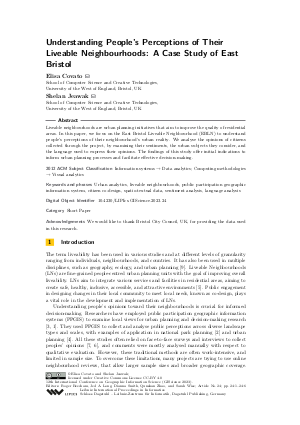@InProceedings{covato_et_al:LIPIcs.GIScience.2023.24,
author = {Covato, Elisa and Jeawak, Shelan},
title = {{Understanding People’s Perceptions of Their Liveable Neighbourhoods: A Case Study of East Bristol}},
booktitle = {12th International Conference on Geographic Information Science (GIScience 2023)},
pages = {24:1--24:6},
series = {Leibniz International Proceedings in Informatics (LIPIcs)},
ISBN = {978-3-95977-288-4},
ISSN = {1868-8969},
year = {2023},
volume = {277},
editor = {Beecham, Roger and Long, Jed A. and Smith, Dianna and Zhao, Qunshan and Wise, Sarah},
publisher = {Schloss Dagstuhl -- Leibniz-Zentrum f{\"u}r Informatik},
address = {Dagstuhl, Germany},
URL = {https://drops.dagstuhl.de/entities/document/10.4230/LIPIcs.GIScience.2023.24},
URN = {urn:nbn:de:0030-drops-189194},
doi = {10.4230/LIPIcs.GIScience.2023.24},
annote = {Keywords: Urban analytics, liveable neighbourhoods, public participation geographic information system, citizen co-design, spatio-textual data, sentiment analysis, language analysis}
}

 Creative Commons Attribution 4.0 International license
Creative Commons Attribution 4.0 International license












